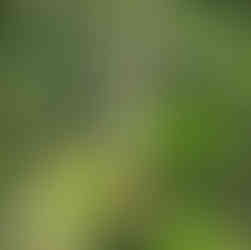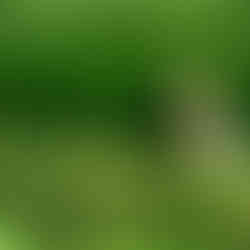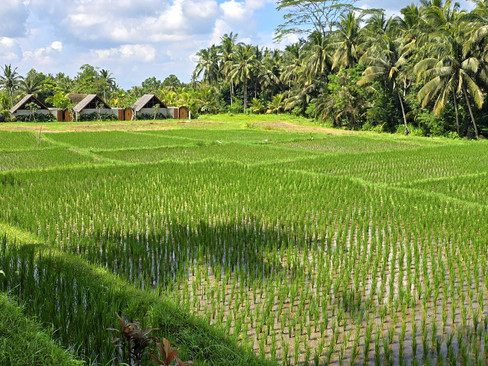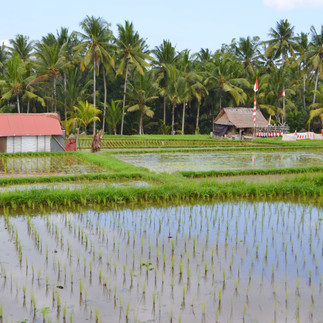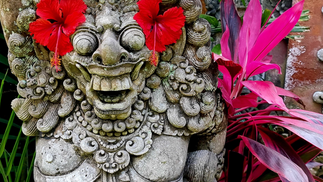Kajeng Rice Fields Loop
- Shannon
- Sep 17
- 4 min read
The Rural Heartbeat of Ubud
Slicing through glittering, gently terraced rice fields and fringed by towering coconut palms, the Kajeng Rice Fields Walk is arguably one of the prettiest treks you can do in the cultural capital of Ubud without a guide. Kajeng offers a rare and intimate glimpse into Bali’s traditional agricultural life, set against a landscape that’s both serene and alive with quiet purpose. Unlike curated tourist spots, this 4.5 km loop begins just minutes from central Ubud yet quickly leaves the noise behind. The footpath winds past narrow canals, small thatched homes and freshly tended paddies, many still hand-worked by local farmers. Despite its accessibility, the walk has maintained a rural authenticity, largely due to the enduring structure of the Subak system, which continues to govern the rhythm of rice production here.

"Subak" refers a centuries old cooperative water management system unique to Bali and recognised by UNESCO as part of the island’s Cultural Landscape. Developed in the 9th century, Subak reflects a blend of practical engineering and spiritual philosophy rooted in Tri Hita Karana, the Balinese principle of harmony between people, nature and the divine. Each Subak is led by a Pekaseh (head of the collective), who helps coordinate planting schedules, resolve disputes and ensure that religious ceremonies are performed in accordance with the needs of the land and its spirit.

Central to the spiritual side of rice farming is the worship of Dewi Sri, the rice goddess, whose presence is invoked through daily offerings placed in small shrines dotting the fields. These offerings, made from woven palm leaves, flowers, rice and incense, are not merely decorative, they’re active spiritual appeals for health, abundance and protection. The placement of these shrines is deliberate, often positioned at irrigation junctions or corners of the paddies where the flow of water is seen as especially sacred.
The Kajeng and the adjoining Juwuk Manis rice fields are not only about agriculture, they’re part of a living ecosystem. The shallow paddies attract a variety of birds, including kingfishers, egrets and herons, while dragonflies buzz through the air, particularly in the early morning. Seasonal flowers, such as wild heliconias and frangipani, grow along the embankments and the soundscape is a soft layering of birdsong, rustling palms and distant chatter from warungs or farmers at work.

What makes this walk particularly unique is how human activity and natural beauty coexist. Farmers may pause to wave as they till the fields with hand tools or small motorised plows, while local children chase kites overhead, especially during the dry season when the wind is strong. These daily scenes are not staged, they’re part of a functioning community shaped around the rhythm of rice. The loop’s design also allows for a slow immersion, no two steps feel quite the same as the light shifts and new vistas open at each turn.

On clear days, the silhouette of Mount Agung looms in the distance, adding a sense of spiritual scale. To the Balinese, Agung is the axis of the world, the seat of gods and ancestral spirits. Its visibility from Kajeng isn't just scenic, it's symbolically powerful. Walking this route becomes a kind of pilgrimage in itself, whether you realise it or not. It's a quiet, unforced interaction with a landscape where faith, toil and time have long been in balance.

🗺️ Location
Jalan Kajeng No.88, Ubud, Kabupaten Gianyar, Bali, Indonesia
🚆 How to get there
From Ubud Market, head west along Jalan Raya Ubud toward the Campuhan Bridge, passing a row of shops and warungs. Just before the bridge, look to the right for a small sign that reads “Subak Juwuk Manis” or “Magical Rice Field in Ubud”, this marks one of the main entrances to the Kajeng Rice Fields Loop. Alternatively, you can begin the walk from Jalan Kajeng, a narrow street just a few steps north of Ubud Palace. This route is especially popular as it leads past the well-loved Sweet Orange Warung, a peaceful café tucked among the rice paddies that makes for a perfect rest stop or halfway point. Both entrances connect to the same scenic loop through Bali’s living landscape, offering a quiet and authentic escape just minutes from central Ubud.
⭐ Attraction Info
This activity will only cost you time and energy but the rewards are many. The best time to explore the Kajeng Rice Fields Loop is at sunrise or just before sunset, when the air is cooler and the light casts a warm glow over the landscape. Midday can be intensely hot, so bring plenty of water, wear sunscreen and consider a hat. Along the path, you’ll find several small cafés and traditional warungs tucked between the fields, offering a chance to rest and enjoy a drink or snack with stunning views. With its lush paddies, flower-lined trails and distant mountain views, the loop is incredibly photogenic, so don’t forget your camera. Whether you're after quiet reflection or vibrant scenes of daily life, this peaceful walk offers a refreshing escape right on Ubud’s doorstep.

Thanks for reading about the Kajeng Rice Fields Loop. Check out more amazing destinations here!








